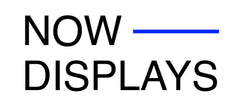Shoppers make snap judgments about products in just 90 seconds, and most of that assessment is based on sight, color, and visual aesthetics alone. It is so important that your store looks so visually appealing in a blink of an eye and captures the shopper’s attention.
What are fixtures in a store?
What is a retail store fixture? If we put it simply, fixtures are the structures, displays, and fittings used in retail businesses to exhibit merchandise. They're the backbone of the store's layout. Therefore, ensuring products are organized, easily accessible, and appealing to customers.
Types of retail display fixtures
- Shelving Units: Shelving units are shop fixtures that provide a platform for displaying a variety of products. From simple wall mounted shelves to free-standing gondolas, they come in various sizes, shapes, and materials to suit different store layouts and themes.
- Display Tables: These versatile fixtures add a touch of elegance to any store while offering a perfect spot to showcase featured or seasonal products. To attract shoppers' attention, display tables might be carefully positioned near entrances, aisle ends, or focal spots.
- Clothing Racks: As the name suggests, clothing racks are designed to showcase apparel, but they're not limited to fashion stores alone. Similarly, these fixtures are available in a variety of configurations, including rounders, four-ways, and specialized racks, making it simple to display garments in a clean and visually appealing manner.
The 4 Elements of an Effective Retail Store Fixture

Visual Appeal and Branding
The visual appeal of the retail store is one of the main elements. Shoppers are attracted to visually appealing displays. And, that is why it is critical to match the fixture design to your brand's identity.
Imagine a boutique clothing store with beautifully crafted wooden shelves, adorned with soft, warm lighting. The fixtures go in with the store's rustic brand image. Additionally, it creates an inviting atmosphere that entices customers to explore further.
Functionality and Flexibility
Practicality is key here - the fixture should be designed to accommodate the specific products you sell and their varying sizes. Adjustable shelving, adjustable components, and modular designs can increase the versatility of the fixture. Moreover, it will allow you to adapt to changing product lines or shop layouts.
Consider a bookstore that uses versatile bookshelves with adjustable shelf heights. This enables them to showcase different book sizes neatly, whether they're displaying hefty hardcovers or pocket-sized paperbacks.
Traffic Flow and Spatial Planning
The layout of your retail store is an extremely important aspect that you need to prioritize. Moreover, an effective fixture should contribute to a well-defined traffic flow, preventing overcrowding and making navigation effortless. Understanding how customers move around your store can help you strategically position fixtures to maximize visibility and accessibility.
For example, a grocery store would place essential items like bread and milk at the back, forcing customers to traverse the entire store, increasing the likelihood of additional purchases along the way.
Highlighting Products and Storytelling
A great retail fixture has the ability to turn ordinary things into intriguing stories. The fixture should showcase significant goods and inspire customers to interact with them, whether through creative visual merchandising or intelligent product placement. Use displays to inspire a connection between customers and products, showing them how the items can solve problems or enhance their lives.
Consider a hardware store with a DIY project corner, complete with a workbench and pegboard-mounted tools. This fixture not only showcases the tools but also sparks customers' imaginations, inspiring them to take on exciting home improvement projects.

